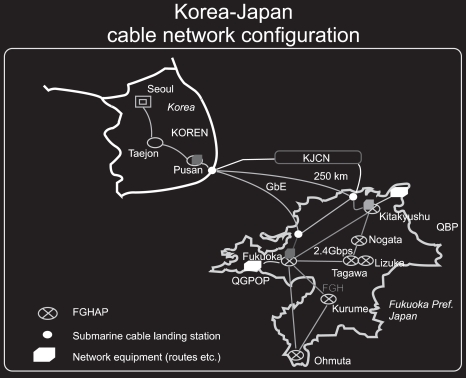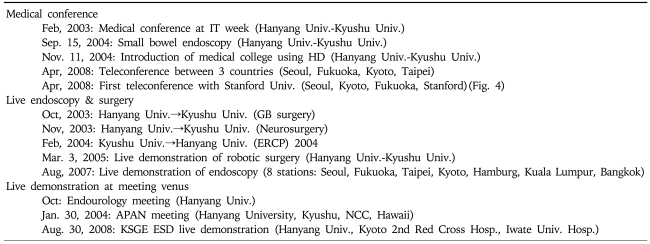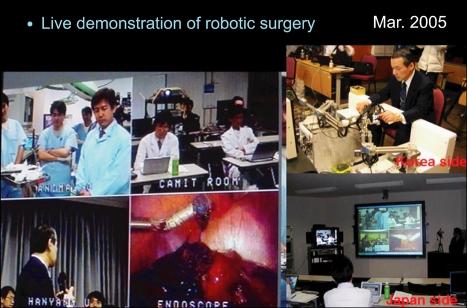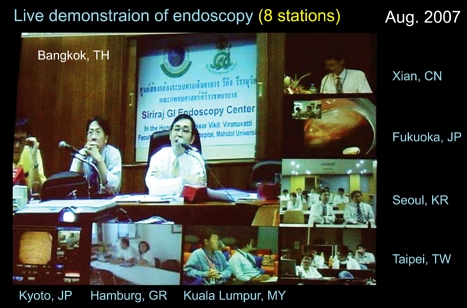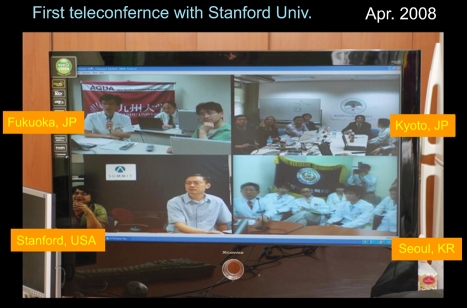Abstract
There is no doubt that telecommunication saves a great deal of time and expense when exchanging information, and recent technological advances have increased its popularity in business and educational applications. Telemedicine is a rapidly developing application of clinical medicine in which medical information is transferred via the Internet or another communication network for the purpose of consultations, and sometimes also for remote medical procedures or examinations. A telemedicine system can also be applied to medical education. Many doctors and medical students could benefit from telementoring and tele-education based on videoconferencing systems. However, telemedicine in general has not yet become popular in clinical practice or medical education. In our university, we have used a telemedicine system to educate doctors and medical students since 2003. Since our first telemedical conference with Kyushu University Hospital on February 12, 2003 when we have regularly performed telemedical conferences. Here we introduce a general methodology for telemedicine, our experiences of medical conferencing using telemedicine, and future possible directions.
Keywords: Telemedicine, Digital video transport system
INTRODUCTION
Advances in internet technology have greatly contributed to practically every aspect of our life and also on computerization and automation of medicine. In recent years, increasing attention had been given to the development and practice of telemedicine.1 Telemedicine is a convenient and efficient tool for remote education in various fields. Recently, robust research efforts some great achievements of telemedical care between domestic hospitals.2 The telemedicine system can also be applied to the education of doctors and medical students.3-6
We established big broad band network and have shared medical knowledges between Asian-Pacific countries using high speed network. And we have a regular conference with Japan, Taiwan, and USA through telemedicine. And more, we performed a live endoscopic submucosal dissection procedure conference under the auspices of the Korean Society of Gastrointestinal Endoscopy (KSGE) through telemedicine. Telemedicine is expected to soon be widely used in medical conference and seminar not also domestic but also international.
In this review, we will introduce a general methodology of telemedicine and also our experiences of medical conference using telemedicine and future direction.
MATERIALS AND METHODS
1. Establishment of network (Fig. 1)
Fig. 1.
Configuration of the Korea-Japan cable network between Hanyang University Hospital, Seoul, and Kyushu University Hospital, Japan. Fukuoka is used to as an intermediary between Busan and Seoul.
An advanced network for telemedicine required a digital camcorder to catch the global view of the personnel and the environment of the operating room, an analog camera mounted on the astral lamp to have the picture of the operating table, and an image splitter installed in the operating room. The operating room was connected to a seminar room to serve as a place for live discussion about the operation, and a network was connected to Kyushu University Hospital, Fukuoka, Japan. This project was established as a joint project of Hyunhae/Genkai project and made use of APII link and Korea Advanced Research Network (KOREN), both of which were constructed with the assistance of the Korean National Computerization Agency subsidiary to the Ministry of Information-Communication. APII link cable was laid in the bottom of the sea for 300 km distance between Busan and Fukuoka, and 300 km distance between Busan and Hanyang University in Seoul was connected by KOREN. The first video conference between Hanyang University Hospital and Kyushu University Hospital took place on February 12, 2003.7
2. Design of system
We set up a teleconference system with bidirectional transmission over the network via Internet Protocol. The Digital Video Transport System (DVTS) was used for sending and receiving both visual and audio signals. DVTS is an application for sending and receiving Digital video (DV) streams using the Internet, which employs differentiated data transmission to send full resolution moving images to remote stations. It is a high quality real-time audio visual (AV) communication tool, transforming DV digitals directly into internet protocol (IP) without any analog conversion. It was invented by Ogawa and Kobayshi et al. in Japan and was first demonstrated at a Super Computer Conference in 1988.8,9 DVTS is a simple method of transmitting high-quality video/audio over the internet. And it also brings internet video production within reach for broad range of organizations. It is available as hardware or as software only, downloaded and installed on a personal computer. DVTS have many advantages. It supports high quality video, little time delay, less expensive and simple.10 First advantages of DVTS is the transmitted quality of the moving images is as high as the source image and is much better than that for conventional systems, because there is no compression process. The second advantage is the time delay is minimal because time-consuming compression is omitted. The third advantage is practically no initial investment is required to set up the system, because only a regular personal computer is required; there is no need for costly specialized teleconferencing instruments.
DVTS is freely downloadable software (http://www.sfc.wide.ad.jp/DVTS/) which can be installed on a personal computer (PC) running either Windows or MacOSX. The DV camera or video output from medical devices is connected to the PC via an IEEE 1394 interface that can connect to broadband Internet. Audio is transmitted simultaneously with the image.
For real-time demonstration of endoscopic surgery, the operating room was connected to the conference room via two DVTS data streams. One was dedicated to transmission of the surgical images to preserve the image quality, and the other was for views of the operating room, preoperative images, or images of staff in the conference room, which could be selected by turning a switch. The two DVTS streams then were transmitted to a counterpart hospital. The endoscopic surgical image, produced at the interface of surgical instruments was converted into Internet protocol packets by the DVTS hardware. Meanwhile, images of operating room, images of the surgeon's manual manipulations, radiographic images, and images of the conference room was obtained by a digital video camera connected to the hardware DVTS via an IEEE1394 interface. Security software (C4-VPN; Focus Systems Co., Tokyo, Japan) was used during real-time transmission to protect each patient's privacy.
PAST AND PRESENT OF OUR TELEMEDICINE
Telemedicine has opened the door to a wide range of learning experience and simultaneous feedback to doctors and students at various remote locations. The merits of telemedicine are as follows. First, it is possible to have a medical practice and give medical advice even from a remote site without spatial limitation. Second, availability of diagnostic tests at a remote hospital eliminates the necessity to be equipped with expensive machines, and inter-institutional share of a patient's records is possible. Third, teleconferencing enables doctors to share medical knowledge at a low cost, and telemedical education of medical students is possible.11-13
In our university, we applied a telemedicine system to the education of doctors and medical students since 2003 (Table 1). We had a first telemedical conference with Kyushu University Hospital in February 12, 2003. Various endoscopic pictures transmitted each other without any problem.
Table 1.
Achievement in 2003-2008
In October 8, 2003, four endoscopic surgeries were successfully transmitted between Seoul and Kyushu, while concomitant teleconferences were taken place between the two throughout the operations. Several live transmissions of operations were successfully carried out as preliminary experiments, including the transmission from the operating room to a seminar room and to Japan. During the operation, the operating surgeons and observers were able to discuss about the surgical process. The operations transmitted live were laparoscopic cholecystectomy and laparoscopic radical prostatectomy, and the anatomic structures could be well recognized and the whole process of operations was well understood during the operations. The quality of transmitted video image had no frame loss with a rate of 30 images per second. The sound was also clear, and time delay was less than 0.3 second.
On March 2, 2005, we had a live demonstration of robotic surgery. Robotic surgery equipments were prepared in Hanyang University Hospital. On the contrary, animal who were performed a cholecystectomy prepared in Japan. Surgeon performed a cholecystecomy with robotic surgery equipments through telemedicine (Fig. 2).
Fig. 2.
Live demonstration of robotic surgery.
Live demonstration of endoscopy as many as 8 stations (7 countries) at the same time were carried out on August 2007. Eight stations were Xian, Fukuoka, Seoul, Taipei, Kuala Lumpur, Hamburg and Kyoto. The results of multi-station performance were satisfied except some problems like as sound troubles, time delay (Fig. 3).
Fig. 3.
Live demonstration of endoscopy with eight stations.
And more, we performed a live endoscopic submucosal dissection (ESD) procedure conference under the auspices of KSGE through telemedicine. Our KSGE hold annually a live ESD conference by satellite communication system. However, there were many problems in this system. First, many patients and endoscopist should come in only one place. In general, many patients avoid transfer to another hospital to receive ESD. Second, the cost of satellite communication is very expensive. On August 30, 2008, KSGE held a live ESD conference with telemedicine. About one thousand Korean endoscopists gathered in Grand Hilton Hotel, Seoul, Korea. In morning session, live ESD procedures performed in Kyoto 2nd Red Cross Hospital & Iwate University Hospital in Japan were transferred with telemedicine to Grand Hilton hotel grand ball room. In afternoon session, ESD procedures performed in Hanyang University and Korean National cancer center were also transferred. According to a questionnaire received by attendance, there were no significant differences between satellite communication and telemedicine system in video and voice quality during live demonstration. We performed the comparative study during live ESD conference. This aim of this study is that the availability of DVTS in remote education system are compared with satellite broadcasting system (SBS) by questionnaire at the point of televiwer. After endoscopic live demonstration under the auspices of the Korean Society of Gastrointestinal Endoscopy at August 31th 2008, we made up a question for degree of satisfaction about image and sound using DVTS and SBS. Ninety-six participants of total 850 to register, who attended demonstration lecture and answered for all questions were enrolled. A questionnaire was composed of 11 items such as comparison for quality of image, time delay between image and sound, preference of image (DVTS vs SBS). Then, preference between DVTS with SBS based on questionnaire at the point of televiwer, was analyzed. Rate of session participation was 77% for SBS, 84% for DVTS. On question for image quality, SBS was more preferable than DVTS (65.6% vs. 16.7%). But, 16.7% of participants answered 'No difference' between DVTS and SBS. For question of 'which media was more little time delay between image and sound?', 62.5% of participants preferred SBS. 'No difference' was 24%, and 11.5% was more preferable for DVTS. Response for satisfaction when endoscopic lecture demonstrate with combining DVTS with SBS was 68% as 'Good', 22% as 'Very Good'. DVTS will prove to be a promising tool in remote medicine and various active utilization of this network will devote the development of diverse medical service and science with satisfaction for televiewer.14
FUTURE OF TELEMEDICINE
Telemedicine system using high speed network can be used whole variety of medical contents. For example, surgery, endoscopy, medical informatics, pathology, interventional radiology, medical e-lecture and teleconsultation are included. This telemedicine system has three characteristics. One is a broadband system. It can be easily used anywhere with some equipments. Second is a free charge for international communications. Third is a high quality system. Although this telemedicine system has many advantages, some requirements are needed for advanced telemedicine project. Namely, only medical staffs could not success this project. Competent engineering staffs supporting medical staffs are needed. And government's supports are inevitable. These three components should be organized systematically to success advanced telemedicine project. We believe telecommunication system will have a substantial impact on telemedicine because distant healthcare providers can share high-quality moving medical imagery equal to that produced by the original equipment. Our goal is to exchange medical information with original quality beyond geographic borders using an easy and economical system and to provide every patient with better healthcare through medical standardization.
Fig. 4.
First teleconference with Stanford University.
ACKNOWLEDGEMENTS
This work was supported by the research fund of Hanyang University (HY-2007-C).
References
- 1.Harris BA., Jr Telemedicine: a glance into the future. Mayo Clin Proc. 1994;69:1212–1214. doi: 10.1016/s0025-6196(12)65777-2. [DOI] [PubMed] [Google Scholar]
- 2.Broderick TJ, Harnett BM, Doarn CR, Rodas EB, Merrell RC. Real-time Internet connections: implications for surgical decision making in laparoscopy. Ann Surg. 2001;234:165–171. doi: 10.1097/00000658-200108000-00005. [DOI] [PMC free article] [PubMed] [Google Scholar]
- 3.Hahm JS, Lee HL, Kim SI, et al. A remote educational system in medicine using digital video. Hepatogastroenterology. 2007;54:373–376. [PubMed] [Google Scholar]
- 4.Hahm JS, Shimizu S, Nakashima N, et al. Telemedicine with digital video transport system. Korean J Gastroenterol. 2004;43:370–375. [PubMed] [Google Scholar]
- 5.Shimizu S, Nakashima N, Okamura K, et al. International transmission of uncompressed endoscopic surgery images via superfast broadband Internet connections. Surg Endosc. 2006;20:167–170. doi: 10.1007/s00464-005-0282-7. [DOI] [PubMed] [Google Scholar]
- 6.Heatley DJ, Bell GD. Telemedicine in gastrointestinal endoscopy. Endoscopy. 2003;35:624–626. doi: 10.1055/s-2003-40223. author reply 627-628. [DOI] [PubMed] [Google Scholar]
- 7.Shimizu S, Hahm JS, Kim YW, et al. Telemedicine with digital video transport system over the Korea-Japan cable network. J Korean Soc Med Inform. 2003;9(Suppl):S322–S326. [Google Scholar]
- 8.Ogawa A, Kobayashi K, Sugiura K, Nakamura O, Murai J. Design and implementation of DV stream over Internet. 1999 Internet Workshop, IWS 99; 18-20 February 1999; Osaka University Convention Center, Suita, Osaka, Japan. Piscataway: IEEE Operations Center; 1999. pp. 255–260. [Google Scholar]
- 9.WIDE project & DVTS Consortium. Demonstration of DVTS at Super Computer Conference 98 [Internet] Fujisawa, Japan: WIDE project & DVTS Consortium; 1998. Available from: http://www.sfc.wide.ad.jp/DVTS/sc98.html. [Google Scholar]
- 10.Telemedicine: fad or future? Lancet. 1995;345:73–74. [PubMed] [Google Scholar]
- 11.Kim CY, Etemad B, Glenn TF, et al. Remote clinical assessment of gastrointestinal endoscopy (tele-endoscopy): an initial experience. Proc AMIA Symp. 2000:423–427. [PMC free article] [PubMed] [Google Scholar]
- 12.Broderick TJ, Harnett BM, Merriam NR, Kapoor V, Doarn CR, Merrell RC. Impact of varying transmission bandwidth on image quality. Telemed J E Health. 2001;7:47–53. doi: 10.1089/153056201300093912. [DOI] [PubMed] [Google Scholar]
- 13.Rabenstein T, Maiss J, Naegele-Jackson S, et al. Tele-endoscopy: influence of data compression, bandwidth and simulated impairments on the usability of real-time digital video endoscopy transmissions for medical diagnoses. Endoscopy. 2002;34:703–710. doi: 10.1055/s-2002-33568. [DOI] [PubMed] [Google Scholar]
- 14.Yoon JH, Hahm JS, Lee HL, Choi HS, Park YJ. Comparison of a digital video transfer system with a satellite broadcasting system used in a teleconference: from the trainee point of view. Korean J Gastrointest Endosc. 2009;39:22–29. [Google Scholar]



